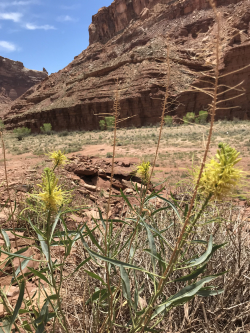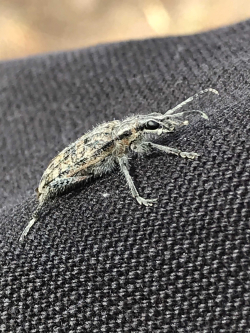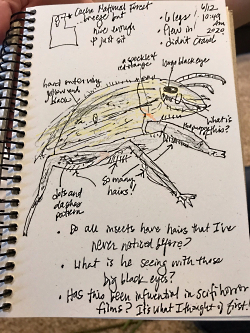
Courtesy & © Shannon Rhodes, Photographer
Nature journaling is nothing new. Charles Darwin kept thousands of observation field notes. Lewis and Clark documented our American West as well. In Jacqueline Davies’ children’s picture book “The Boy Who Drew Birds,” John James Audubon says, “I will bring …my pencils and paper… I will study my cave birds every day. I will draw them just as they are.” As a school teacher, I ask my students as we explore the magic of Hardware Ranch, Bear River Bird Refuge, and Logan River to write and to draw. We carry composition notebooks, erasers, colored pencils, magnifying glasses, and rulers in sealable plastic bags. We date and title each entry, noting the weather and our location on outlines of Utah, and then get into the details from our five senses. What do we see, hear, smell, feel, and, sometimes even taste, like when we are at Antelope Island with Friends of the Great Salt Lake naturalists learning about pickleweed?
The children don’t always have the luxury of just snapping a picture with an iPad or smartphone on our place-based field learning experiences, and I hope that their engagement with and blossoming attitudes about keeping nature journals stick. In the book “Keeping a Nature Journal,” Clare Walker Leslie quoted Frederick Franck about just this: “I have learned that what I have not drawn I have never really seen.” I know I am not alone in thinking, especially when I am not wearing my teacher hat, that I lack the skills to draw natural subjects in any recognizable way. That cannot be an excuse, though, for not taking the time to quietly contemplate what I’m experiencing, being mindful, as naturalist Ernest Thompson Seton wrote, once “the ripples of my presence settle and let nature resume,” and recording it on paper as a permanent memory. There are some who say that we should be present in the moment outdoors and create a journal entry of the most striking memories upon return, but I would submit that engaging in trying to capture nature in a field journal in the moment only heightens the entire wild experience. I’ll share two examples from my recent adventures.

San Rafael Swell
Courtesy & © Shannon Rhodes, Photographer

Cache National Forest
Courtesy & © Shannon Rhodes, Photographer
 “The Flying Critter on My Pant Leg”
“The Flying Critter on My Pant Leg”
Nature Journal Entry
Courtesy & © Shannon Rhodes, Illustrator & Photographer
Last Saturday I was in Cache National Forest swinging in a hammock surrounded by fluttering aspen. A flying critter landed on my pant leg, and I immediately zoomed in on it with my phone’s camera. It didn’t move, and neither did I, as I scrambled for a paper and pen. I am not as good at identifying insects with my field guides, but I took the time to really get to know this hairy creature with huge black eyes. Brian Mertins, a naturalist who has compiled tips for a better nature journal, warns that drawing from observation “burns a clear image of whatever you are sketching into your memory.” That is certainly the case with this interaction I had: the way his antennae curved down in front of his face, the speckled colors of his hard outer wing, those mesmerizing eyes staring me down for an uncomfortably long time.
I am convinced that every time I open my nature journal to that page, I will remember that day with that hairy insect, and I am also convinced that I’ll never know all there was to appreciate about that bee plant I failed to take the time in the moment to capture in my field journal. There are so many resources online about nature journaling techniques, from a formal Grinnell-style field journal to tips for drawing flowers and bugs. There are also opportunities for citizen scientists interested in contributing to Notes from Nature projects sponsored by the Smithsonian Institute and zooniverse.org to digitally transcribe field journals. Explore the possibilities to be wild about nature journaling.
This is Shannon Rhodes, and I am wild about Utah.
Credits:
Images: Courtesy & Copyright Shannon Rhodes, Photographer
Audio: Courtesy & © Kevin Colver https://wildstore.wildsanctuary.com/
Text: Shannon Rhodes, Edith Bowen Laboratory School, Utah State University https://edithbowen.usu.edu/
Additional Reading Links: Shannon Rhodes
Additional Reading:
American Museum of Natural History. Keeping a Field Journal: Eleanor Stirling. https://www.amnh.org/learn-teach/curriculum-collections/biodiversity-counts/what-is-biodiversity/keeping-a-field-journal-1-eleanor-sterling
Davies, Jacqueline. The Boy Who Drew Birds: A Story of John James Audubon. 2004. https://www.jacquelinedavies.net/theboywhodrewbirds
iNaturalist, https://www.inaturalist.org/
Laws, John Muir. Opening the World Through Nature Journaling. 2012. https://sdchildrenandnature.org/wp/wp-content/uploads/2013/05/CNPS_NatureJournaling_JMuirLaws_96p_2012.pdf
Leslie, Clare Walker and Roth, Charles E. Keeping a Nature Journal: Discover a Whole New Way of Seeing the World Around You. 2000. https://www.storey.com/books/keeping-a-nature-journal-3rd-edition/
MacMahon, James A. Deserts, National Audubon Society Nature Guides. Knopf; A Chanticleer Press, 1998. https://www.worldcat.org/title/deserts/oclc/37144389
All Guides: https://www.audubon.org/national-audubon-society-field-guides
Mertins, Brian. Beginner’s Guide to Nature Journaling: 12 Tips for a Better Nature Journal. https://nature-mentor.com/nature-journaling/
Smithsonian Center for Education and Museum Studies. Introduction to the Nature Journal. 2006. https://www.smithsonianeducation.org/educators/lesson_plans/journals/smithsonian_siyc_fall06.pdf
Smithsonian Institution Field Guide Digital Transcription Project, https://transcription.si.edu/
Thompson, Elizabeth. Nature Journaling Binder. 2014. https://thewatershed.org/pdf/Education/NatureJournalingWebversion.pdf
